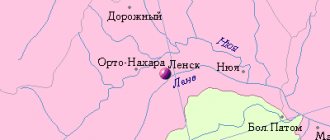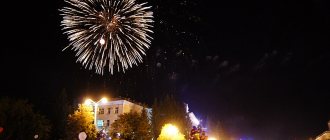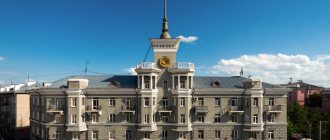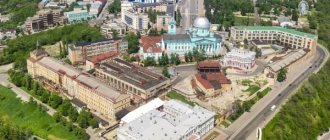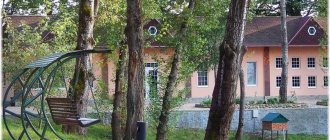For other localities in Russia with the same name, including in Krasnoyarsk Krai, see Borodino, Russia.
City in Krasnoyarsk Krai, Russia
| Borodino Borodino | |
| City [1] | |
| Monument to Vladimir Lenin in Borodino | |
| Flag Coat of arms | |
| Location of Borodino | |
| Borodino Location of Borodino Show map of Russia Borodino Borodino (Krasnoyarsk region) Show map of Krasnoyarsk Territory | |
| Coordinates: 55°54′20″N 94°53′59″E / 55.90556°N 94.89972°E / 55.90556; 94.89972 Coordinates: 55°54′20″N 94°53′59″E / 55.90556°N 94.89972°E / 55.90556; 94.89972 | |
| A country | Russia |
| Federal subject | Krasnoyarsk region [1] |
| Based | 1949 [2] |
| City status from | 1981 [2] |
| Height | 330 m (1080 ft) |
| Population (2010 Census) [3] | |
| • General | 17 416 |
| Administrative status | |
| • Subordinate | region of Borodino [1] |
| • Capital from | region of Borodino [1] |
| Municipal status | |
| • Urban district | Borodino urban district [4] |
| • Capital from | Borodino urban district [4] |
| Timezone | UTC+7 (MSK+4[5]) |
| Postal code [6] | 663980, 663981 |
| OKTMO ID | 04707000001 |
| Web site | www.sibborodino.ru |
Borodino
(Russian: Borodino) is a city in Krasnoyarsk Krai, Russia, located 186 km (116 mi) northeast of Krasnoyarsk, the administrative center of the region. Population: 17,416 people (according to the 2010 census); [3] 19,181 (2002 census); [7] 18,426 people (1989 census). [8]
Links[edit]
Notes[edit]
- ^ abcde Law No. 10-4765
- ^ abcd Encyclopedia of Russian Cities
. Moscow: Great Russian Encyclopedia. 2003. p. 55. ISBN 5-7107-7399-9. - ^ a b Federal State Statistics Service (2011). All-Russian Population Census 2010. Volume 1 [All-Russian Population Census 2010, vol. 1]. All-Russian Population Census 2010 [All-Russian Population Census 2010] (in Russian). Federal State Statistics Service.
- ^ abc Law No. 12-2507
- "On the Calculation of Time". Official Internet portal of legal information
. June 3, 2011. Retrieved January 19, 2021. - Post office. Information and computing center of OASU RPO. ( Post office
).
Search for postal service objects ( postal Search for objects
) (in Russian) - ↑
Federal State Statistics Service of Russia (May 21, 2004). The population of the Russian Federation, cities of the Russian Federation as part of federal districts, urban settlements, settlements, settlements, settlements is 3 thousand or more people. [Population of Russia, its federal districts , subjects of the Federation, districts, urban settlements, rural settlements - administrative centers and rural settlements with a population of more than 3000 people] (XLS). All-Russian Population Census of 2002 [All-Russian Population Census of 2002] (in Russian). - All-Union Population Census of 1989 Population of Union and Autonomous Republics, Autonomous Regions and Districts, Territories, Regions, Urban Settlements and Village District Centers [All-Union Population Census of 1989: Current Population of Union and Autonomous Republics, Autonomous Regions and Districts, Territories, Regions , districts, urban settlements and villages performing the functions of district administrative centers]. All-Union Population Census of 1989 [All-Union Population Census of 1989] (in Russian). Institute of Demography of the National Research University: Higher School of Economics [Institute of Demography of the National Research University: Higher School of Economics]. 1989 - via Demoscope Weekly
.
Borodino: memorial city
There have always been many villages and villages with the name Borodino in Russia, as well as Ivanovka, Olkhovok, Berezovok and others. But it is clear that for world history there is only one Borodino, which was reflected in the name of first the village in the depths of Siberia, then the city.
According to one version, the village was named this way by soldiers of the Semenovsky Life Guards Regiment, exiled to this region for the riot of 1820, who wished to perpetuate the memory of the great battle in which they participated.
By the way, nearby Tarutino is also said to have received its name for the same reason. However, they claim that it was not the exiled Semyonovites who did this, but the first Yenisei governor, Alexander Petrovich Stepanov. A participant in Suvorov's Italian campaign, awarded the order for the crossing of St. Gotthard and the battle at the Devil's Bridge, he went through the Patriotic War, in today's terms, as a rear man, but he revered its memory sacredly. So he called it.
One way or another, all paths lead to “that same” Borodino... And when a city appeared next to the village, it also bore the stamp of great History, in which, as we know, the glorious and the tragic are difficult to distinguish.
They say that one day the ground collapsed on the territory of the kindergarten, and a dugout appeared in the hole. This is where the first builders lived. The dugouts housed the bureaucracy, the medical unit and even a hairdresser...
They did not come here of their own free will, since the majority of the “contingent” were interned Soviet prisoners and those who were driven into European slavery - both of them were not greeted very warmly by their homeland, to put it mildly. But those who arrived involuntarily remained here of their own free will - they started families, built houses, gave birth to children and already considered themselves local, Borodino.
REFERENCE
Borodino received city status in 1981. Has the status of a municipal entity.
Established in 1949 as a coal miners' settlement at the Irsha-Borodinsky coal mine. It got its name from the village of Borodino, located five kilometers from the city and located on the Moscow highway.
Construction of the future city began in August 1945. Former Soviet prisoners of war, repatriated to the USSR from France after the defeat of Nazi Germany in World War II, were brought to this place. Then workers began to come to the city for organized recruitment, mainly from the western regions of Russia.
At the end of 1949, the Irsha-Borodinsky coal mine was put into operation, which became the largest coal enterprise in the RSFSR in the 1980s.
Today, the city’s education system has three secondary schools, six libraries, the same number of kindergartens, and two additional education institutions. The city has a children's art school, a House of Crafts, and a station for young technicians.
The main cultural institution is the Ugolshchik House of Culture, whose creative teams are known outside the region and abroad. One of the main attractions of the city is the Youth Sports School, whose students include winners of many international competitions in various sports, including Olympic silver medalist Olga Romasko and Olympic champion Olga Medvedtseva. There are 26 sports facilities, seven gyms, and four swimming pools.
The city has a hospital complex - a clinic designed to accommodate 800 people, and a hospital with 133 beds.
NUMBERS
- Population – 16,249 people.
- Distance to Krasnoyarsk – 155 km
- The nearest railway station is Kamala (9 km)
Economy
- Borodino open-pit mine
- Mechanical repair plant
- Bakery
- Furniture factory
Social sphere and service sector, cultural life[ | ]
| The section lacks links to sources. Information must be verifiable or it may be deleted. You can edit the article to add links to authoritative sources. This mark was set on October 23, 2015 . |
Educational institutions in Borodino are represented by three secondary schools, six libraries, six pre-school educational institutions, and two additional education institutions. The city has a Children's Art School, a House of Crafts, and a Station for Young Technicians.
The city has a hospital complex, which was put into operation in 2004. The complex's clinic can accommodate 800 people per shift, and the hospital has a capacity of 133 beds.
The city publishes a weekly newspaper, Borodino Bulletin. It airs on TV six days a week.
Borodino
(Krasnoyarsk region)
OKATO code:
04407
Founded:
1949
Urban settlement since:
1949
City since:
1981 City of regional subordination
Telephone code (reference phone)
| 39168***** | — |
Deviation from Moscow time, hours:
4
Geographical latitude:
55°54′
Geographical longitude:
94°54′
Altitude above sea level, meters:
330 Sunrise and sunset times of the Sun and Moon in the city of Borodino
Population[ | ]
| Population | |||||||
| 1959[12] | 1970[13] | 1979[14] | 1989[15] | 1996[16] | 1998[16] | 2000[16] | 2001[16] |
| 9921 | ↗10 838 | ↗11 331 | ↗18 426 | ↗19 500 | ↗19 800 | ↗20 000 | ↗20 100 |
| 2002[17] | 2005[16] | 2006[16] | 2007[16] | 2008[16] | 2009[18] | 2010[19] | 2011[16] |
| ↘19 181 | ↘19 000 | →19 000 | ↘18 800 | →18 800 | ↘18 738 | ↘17 416 | ↘17 400 |
| 2012[20] | 2013[21] | 2014[22] | 2015[23] | 2016[24] | 2017[25] | 2018[26] | 2019[27] |
| ↘16 956 | ↘16 764 | ↘16 522 | ↘16 339 | ↘16 218 | ↗16 249 | ↘16 127 | ↘16 061 |
| 2020[2] | |||||||
| ↘16 055 | |||||||
As of January 1, 2021, in terms of population, the city was in 752nd place out of 1,116[28]cities of the Russian Federation[29].
Sport
Since 1982, the city has a children's and youth sports school in six sports: biathlon, cross-country skiing, basketball, judo, football, chess. Honored Masters of Sports biathletes Olga Romasko and Olga Medvedtseva are students of the Borodino Youth Sports School.
The ice hockey team “MINER” trains in the city. Captain Matalyzhenko Andrey. Goals and objectives of the hockey club: - development in the city of Borodino of such a sport as ice hockey; — attracting the maximum possible number of children, adolescents and youth of the city to systematic sports; — organization of physical education, health, sports, educational work among children, adolescents and youth of the city; — popularization of a healthy lifestyle; — improving the level of physical fitness and sportsmanship of the leading athletes of the city ice hockey team.
Also in the city of Borodino there is a club for fans of extreme equipment “NAST”. The purpose of which is to promote a healthy lifestyle.
Local history of Borodino
Sergei Stepanovich Litvinov, our fellow countryman, now a UN and WWF expert consultant, candidate of technical sciences, shared his knowledge about his family, family archives and family values.
The style of the author's text has been preserved.
Litvinov Stepan Pavlovich
, born January 9, 1919, Altai Territory, Blagoveshchensky District, Georgievka village.
Life path of Litvinov S.P. ended on August 21, 1996, he was buried with his wife in a cemetery in Tomsk.
The Litvinovs are an old Cossack family from Rostov-on-Don.
The Litvinovs moved from Rostov-on-Don to Altai to a place now called the Blagoveshchensky district, when, by Catherine’s Decree, families were allocated land according to the number of men.
The family was able to settle well on the land through their own labor. Everyone lived in a large family house and processed bread, melons and other vegetables. In addition, the family kept a large number of domestic animals: horses, cows, sheep, pigs, chickens, etc.
At that time, the local population (Altaians) were constantly hired as seasonal shepherds. The owners drove the sheep out of the gate, counting them by head. At the end of the grazing season, the shepherd had to return the same number of heads of cattle to the owner. All offspring, as well as the death of livestock, were considered risks.
After the advent of Soviet power, this practice was considered exploitation of the working people, and the family fell under a repressive mechanism. The head of the family and his wife (my great-grandmother and great-grandfather) were exiled to the Tomsk region (to Vasyugan). Father (Stepan Pavlovich Litvinov) decided to go with his grandparents.
In the Vasyugan swamps, many exiles died quite quickly. To save their grandson, the grandparents sent Stenka “to the mainland” in Tomsk. Thus began the story of the homeless child Stenka Litvinov. He worked as a child at a pencil factory, pulling logs from the Tom River on horses for processing at the factory. Then he was sent to a shelter for street children in Kemchug, Krasnoyarsk Territory.
According to my father, life there was “not sweet.” There was nothing to eat, street children raided neighboring fields where peasants grew potatoes. The struggle for their property was brutal; if the homeless children were caught up, the last one was killed. One day Stenka was accidentally seen in a shelter by a man who recognized him. He was surprised that the boy was in a shelter for street children when his parents were alive. He informed them about the current situation and Stenka’s father took him home to Altai.
The second wave of repressions for the family ended with deportation to the Krasnoyarsk Territory (to the Udereisky mine). The family was saved by the fact that the older brother (Platon Pavlovich) was able to dig a dugout and they spent the winter after they were “thrown out” of the cars into the snow.
After this, the further fate of the family was connected with the Krasnoyarsk Territory.
Family composition:
Father: Pavel Ivanovich
Mother: Ksenia Paramonovna
Children: Plato, Maria, Stepan, Klimenty
Stepan began his production activities in 1936 at the mine as a mining collector. After working there for 4 years, he went to driver courses and received his specialty as a driver in May 1941. After briefly working in a new capacity at the Mica Factory in Zaozerny, he was drafted into the Red Army for military service in May 1941.
Stepan Pavlovich was sent to the east of the country and was enlisted in the 175th separate construction battalion as a driver. He finished his service with the rank of senior sergeant and was demobilized on May 1, 1946. He served on the 1st Far Eastern Front. He participated in the 109th fortified army. area in hostilities with Japan from August 9, 1945 to September 3, 1945 as a driver-instructor and chemical engineer. instructor. Medal for the victory over Japan, Order of the Patriotic War 2nd class, medal for the victory over Germany and all anniversary medals.
One of my father’s stories about the war stuck with me: “War is hard work. He who is lazy, buries himself poorly, and cannot bear weight, dies first. For example, carrying a protective shield for an anti-tank rifle is the responsibility of number 2. But it’s quite heavy, and you also have to carry weapons and things. a bag, an overcoat...” So several 2nd numbers were killed, and my father wore this shield. In 2015, at an exhibition on Sapun Mountain (Sevastopol, Crimea), I saw this shield and tried to lift it and put it on my shoulders “in a stowed position.” I found it incredibly difficult. Then I clearly understood the words of my father and not only him about the “heaviness of victory.”
After demobilization from the army, my father returned to peaceful work as a mining collector in the Irshinsky geological exploration party (September, 1946). His further career was connected with a number of enterprises and was eventually accepted into the Irsha-Borodinsky open-pit mine management of the Krasnoyarsk Economic Council. In the Borodino open-pit mine, Stepan Pavlovich worked as an assistant to an excavator driver. From January 1967 to September 1969, he headed the mine committee (trade union committee) of the Overburden Mine.
After working at Razrez for almost 30 years, he transferred to the housing and communal services sector, where he worked as an electrician (see article in the Znamya Oktyabrya newspaper). In 1993, Stepan Pavlovich and his wife moved to his son’s family in Tomsk.
Litvinova (Sidorova) Nina Vasilievna
, born December 29, 1922, Yaroslavl region, Yaroslavl district, Pograikha village,
on the Volga, not far from Yaroslavl. Their family had 5 children: 4 brothers and 1 sister.
Parents: father - Sidorov Vasily Stepanovich, mother - Sidorova Trefena Ivanovna.
Vasily Stepanovich was a good painter and worked in an apartment renovation team. Trefena Ivanovna did housework.
Nina graduated from medical school and before the war worked as an obstetrician in the Zavolzhsky maternity hospital.
From March 10, 1943 to July 22, 1946, she served in the Soviet Army as part of the 1st Belorussian Front. She worked as a nurse in a hospital for the slightly wounded. After the end of the war, Nina Vasilievna continued to work in army medical institutions (Germany, Potsdam) as a civilian employee. She retired to the reserve on July 28, 1951 and returned to Yaroslavl, where she continued to work in the medical field. institutions as a paramedic-midwife until July 1, 1955.
Next begins the Siberian part of N.V. Sidorova’s biography. She met S.P. Litvinov at the station in Moscow, who was visiting relatives in Rostov-on-Don. Here they met and tied their future fate with family ties. The family settled in the village of Borodino, st. Oktyabrskaya, house 48, apt. 4.
As a result of this marriage, a son was born - Sergei.
On July 15, 1955, Nina Vasilievna was hired at the Irsha-Borodinsky hospital as a midwife.
Subsequently, after training Litvinova N.V. began working as a dentist and worked in this capacity until July 2, 1970. Many residents of Borodino remember her in this capacity (see article in the newspaper “Znamya Oktyabrya”).
LITVINOV FAMILY
After finishing their working career, the Litvinov family took an active part in the life of Borodino. The two of them took part in performances of the veterans' choir.
They have always been active citizens and took part in public life.
As grandparents, Stepan Pavlovich and Nina Vasilievna took an active part in raising their granddaughters.
From right to left: Litvinov Stepan Pavlovich, granddaughter Dina, granddaughter Anya, Litvinova Nina Vasilievna
In 1993, the Litvinovs moved to Tomsk to be closer to their son’s (Sergei) family. Stepan Pavlovich lived in Tomsk for only 3 years and died on August 22, 1996.
Nina Vasilievna continued to actively participate in public life in Tomsk: she was a member of the regional Veterans Council and helped lonely elderly people. All those residents of Tomsk with whom she communicated remember Nina Vasilievna with great warmth for her cheerful, kind disposition, responsiveness to people and worldly wisdom.
At the holidays dedicated to Victory Day, Nina Vasilievna, like all veterans, enjoyed universal respect and gratitude. They gave her so many flowers that her whole cozy apartment was filled with them.
Nina Vasilievna died on January 30, 2015 at the age of 92 and was buried in the same grave with her beloved husband.
Prepared February 06, 2021
Litvinov Sergey Stepanovich
Not only to repair, but also to replace imports
Coal in Borodino provides employment not only to those who directly work on its extraction.
The Borodino Mechanical Repair Plant celebrates its 45th anniversary in 2021. The last five-year period was a landmark for his team of almost 500 people: the enterprise has significantly increased the volume and range of its products, and now not only services equipment used in coal mining, but also successfully competes in the market of high-tech, innovative products. The work of the BRMZ seems especially important in the context of import substitution, one of the priority goals of the domestic industry today. For example, Alexander Uss is proudly shown the tracks for the Bucyrus 295 HD mining excavator: the elements of the track chains produced by Borodino workers are in no way inferior in quality to their foreign counterparts, and the cost is several times cheaper.
“We are pleased with the constant attention that we receive from the regional authorities and Alexander Uss personally,” notes General Director of JSC SUEK-Krasnoyarsk Andrey Fedorov. — We are now at the stage of increasing production volumes. The mood in the work collectives is positive: since production is growing, wages at the enterprises are also growing.
The city of Borodino is SUEK’s hometown. We cannot imagine ourselves without it, so creating a comfortable environment for our employees is and will be our undoubted priority. After all, the Borodino open-pit mine is not just mineral deposits, but also the backbone of the economy for the entire Krasnoyarsk Territory.
